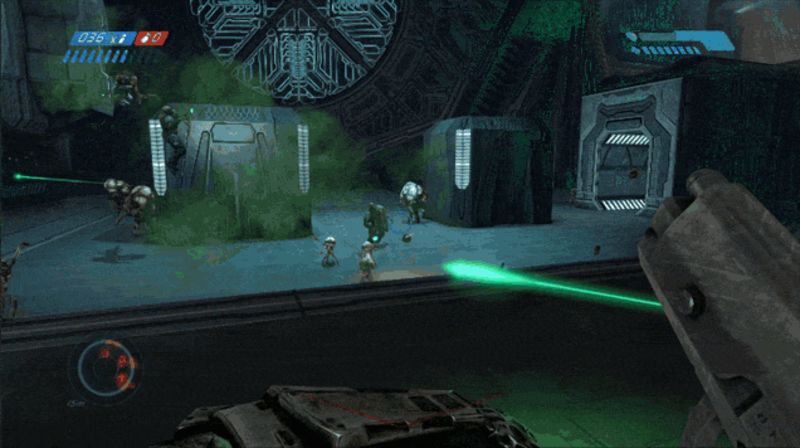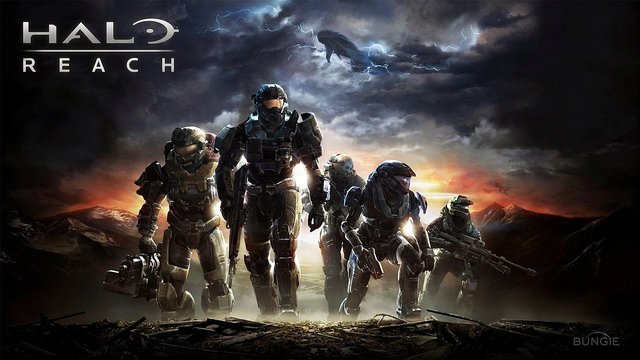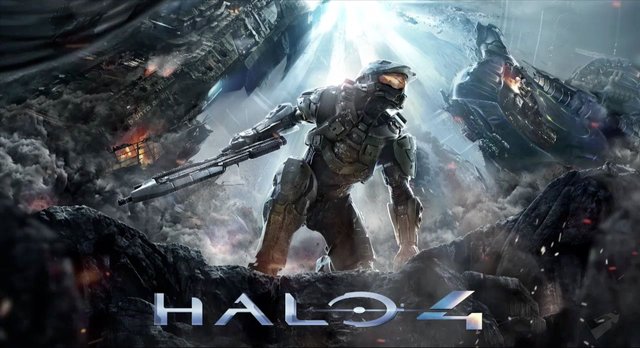The Evolution Of Halo!!!
Halo is a military science fiction first-person shooter video game franchise created by Bungie and now managed and developed by 343 Industries, a subsidiary of Microsoft Studios. The series centers on an interstellar war between humanity and a theocratic alliance of aliens known as the Covenant. The Covenant, led by their religious leaders called the Prophets, worship an ancient civilization known as the Forerunners, who perished in combat with the parasitic Flood. The central focus of the franchise builds off the experiences of Master Chief John-117, one of a group of supersoldiers codenamed Spartans, and his artificial intelligence (AI) companion, Cortana. Other characters, such as Noble Six from Halo: Reach, are also introduced in the series. The term "Halo" refers to the Halo rings: large, habitable superweapons that were created by the Forerunners to destroy the parasitic Flood. They are similar to the Orbitals in Iain M. Banks' Culture novels, and to a lesser degree to author Larry Niven's Ringworld concept.

The games in the series are praised as being among the best first-person shooters on a video game console, and are considered the Xbox's "killer app". This led to the term "Halo killer" being used to describe console games that aspire, or are considered, to be better than Halo. Fueled by the success of Halo: Combat Evolved, and by immense marketing campaigns from publisher Microsoft, its sequels went on to record-breaking sales. The games have sold over 65 million copies worldwide, with the games alone grossing almost $3.4 billion
and this is the evolution of the first genre halo up to now:
Halo: Combat Evolved

Release: November 15, 2001
Halo: Combat Evolved is a 2001 military science fiction first-person shooter video game developed by Bungie and published by Microsoft Game Studios. The first game of the Halo franchise, it was released as a launch title for the Xbox gaming system on November 15, 2001, and is considered the platform's "killer app". More than five million copies were sold worldwide by November 2005. Microsoft released versions of the game for Microsoft Windows and Mac OS X in 2003, and the surrounding storyline was adapted and elaborated into a series of novels, comic books, and live-action web series. The game was later released as a downloadable Xbox Original for the Xbox 360. A high-definition remake, Halo: Combat Evolved Anniversary, was released for Xbox 360 on the 10th anniversary of the original game's launch, and was rereleased as part of Halo: The Master Chief Collection on November 11, 2014, for the Xbox One.
As a first-person shooter, the gameplay of Halo: Combat Evolved is fundamentally similar to that of its peers, focusing on combat in a 3D environment that is viewed almost entirely from a character's eye view. The player can move around and look up, down, left, or right. The game features vehicles, ranging from armored jeeps and tanks to alien hovercraft and aircraft, many of which can be controlled by the player. The game switches to a third-person perspective during vehicle use for pilots and mounted gun operators; passengers maintain a first-person view. The game's heads-up display includes a "motion tracker" that registers moving allies, moving or firing enemies, and vehicles, in a certain radius of the player.

The player character is equipped with an energy shield which nullifies damage from weapons fire and forceful impacts. The shield's charge appears as a blue bar in the corner of the game's heads-up display, and it automatically recharges if no damage is sustained for a brief period. When the shield is fully depleted, the player is highly vulnerable, and further damage reduces the hit points of a secondary health meter. When this health meter reaches zero, the character dies and the game reloads from a saved checkpoint. Health can be replenished through the collection of health packs scattered around the game's levels, but the game's introduction of a regenerating shield mechanic represented a departure from FPS games of the time.
Halo 2

Release: November 9, 2004
After the success of Combat Evolved, a sequel was expected and highly anticipated. Bungie found inspiration in plot points and gameplay elements that had been left out of their first game, including multiplayer over the Internet through Xbox Live. Time constraints forced a series of cutbacks in the size and scope of the game, including a cliffhanger ending to the game's campaign mode that left many in the studio dissatisfied. Among Halo 2's marketing efforts was an alternate reality game called "I Love Bees" that involved players solving real-world puzzles.
Halo 2 is a shooter game, with players predominantly experiencing gameplay from a first-person perspective. Players use a combination of human and alien weaponry and vehicles to progress through the game's levels. The player's health bar is not visible, but players are instead equipped with a damage-absorbing shield that regenerates when not taking fire.

Certain weapons can be dual-wielded, allowing the player to trade accuracy, the use of grenades and melee attacks for raw firepower. The player can carry two weapons at a time (or three if dual-wielding, one weapon remains holstered), with each weapon having advantages and disadvantages in different combat situations. For example, most Covenant weapons eschew disposable ammo clips for a contained battery, which cannot be replaced if depleted. However, these weapons can overheat if fired continuously for prolonged periods. Human weapons are less effective at penetrating shields and require reloading, but cannot overheat due to prolonged fire. The player can carry a total of eight grenades (four human grenades, four Covenant) to dislodge and disrupt enemies. New in Halo 2 is the ability to board enemy vehicles that are near the player and traveling at low speeds. The player or AI latches onto the vehicle and forcibly ejects the other driver from the vehicle.
Halo 3
.jpg)
Release: September 25, 2007
Bungie began developing Halo 3 shortly after Halo 2 shipped. The game was officially announced at E3 2006, and its release was preceded by a multiplayer beta open to select players who purchased the Xbox 360 game Crackdown. Microsoft spent $40 million on marketing the game, in an effort to sell more game consoles and broaden the appeal of the game beyond the established Halo fanbase. Marketing included cross-promotions and an alternate reality game.

Halo 3 is a shooter game where players primarily experience gameplay from a first-person perspective. Much of the gameplay takes place on foot, but also includes segments focused on vehicular combat. The balance of weapons and objects in the game was adjusted to better adhere to the "Golden Triangle of Halo". these are weapons, grenades, and melee attacks, which are available to a player in most situations. Players may dual-wield some weapons, forgoing the use of grenades and melee attacks in favor of the combined firepower of two weapons. Many weapons available in previous installments of the series return with minor cosmetic and power alterations. Unlike previous installments, the player's secondary weapon is visible on their player model, holstered or slung across the player's back.
Halo 3 introduces "support weapons", which are cumbersome two-handed weapons that slow the player, but offer greatly increased firepower in return. In addition to weapons, the game contains a new class of gear called equipment. these items have various effects, ranging from defensive screens to shield regeneration and flares. Only one piece of equipment can be carried at a time. The game's vehicular component has been expanded with new drivable and AI-only vehicles.
after 3 years of the success of Halo 3, Bungie began Halo: Reach in the Xbox 360 series.
Halo: Reach

Release: September 14, 2010
Halo: Reach is a first-person shooter video game developed by Bungie and published by Microsoft Game Studios for the Xbox 360 home video game console. The sixth installment in the Halo series, Reach was released worldwide in September 2010. The game takes place in the year 2552, where humanity is locked in a war with the alien Covenant. Players control Noble Six, a member of an elite supersoldier squad, when the human world known as Reach falls under Covenant attack.
In the game's campaign, which can be played alone or cooperatively, players assume the role of Noble Six, a supersoldier engaged in combat with an alien collective known as the Covenant. The Covenant come in eight distinct varieties with different ranks and classes for each type; for example, Elites are the leaders of a group, while Grunts are less intelligent and only dangerous in large groups. The player is equipped with a recharging energy shield that absorbs damage from weapons, fire and impacts. When the energy shield is depleted, the player loses health. When the player's health reaches zero, the character dies and the game reloads from a saved checkpoint. Health is replenished using health packs scattered throughout Reach's levels. The campaign's encounters with enemies are typically large, open spaces with weapons caches, cover from enemy fire and strategic vantage points. New to the Halo series are dogfight sequences set in space.
.jpg)
Reach features updated versions of old weapons, plus new weapons fulfilling various combat roles. In Halo 3, players can carry single-use equipment power-ups that offer temporary offensive or defensive advantages. This system of single-use equipment is replaced in Reach by reusable and persistent armor abilities that remain with a character until they are replaced. The abilities are a jetpack, active camouflage, sprint; hologram, which creates a facsimile of the player running towards a target point, drop shield, which creates a bubble that heals those inside and protects them from a limited amount of damage; and armor lock, which immobilizes the player but grants invincibility for a brief period of time. When playing as Covenant Elites, players also have access to an evade armor ability.
Halo 4

Release: November 6, 2012
Development of Halo 4 began in 2009 and continued until September 2012. Halo 4 is 343 Industries' first original title within the Halo series—previously, development of the main series was undertaken by Bungie, the creator of the franchise. In the developmental process, 343 Industries decided to explore the Forerunner fiction within the Halo universe, leading the team to design a new setting, enemies, and main antagonist. Existing characters and assets received visual overhauls and motion capture was used for animation within cutscenes. A goal for Halo 4's story was to incorporate more human elements; to achieve this, the developers chose to delve more deeply into the relationship between the two protagonists, Master Chief and Cortana. Several external studios assisted 343 Industries with developing Halo 4, and over 350 people worked on the game in total.

Halo 4 features updated versions of many human and Covenant weaponry from previous Halo games, as well as introducing new weapons for the humans, Covenant and Prometheans. The game also features reusable equipment, called armor abilities, introduced in Halo: Reach. New armor abilities are autosentry, the hardlight shield, which activates a protective barrier similar to a riot shield; Promethean vision, which diminishes environment detail and shows hidden players as silhouettes, a regeneration field, which heals all players in close proximity and can emit a short range kinetic blast; and finally the thruster pack, which allows the player to launch themselves several feet in a horizontal direction. Returning abilities include active camouflage, jetpack, and hologram, which creates a doppelganger of the player running towards a target point. Sprinting returns in Halo 4, however, players can now use it independently of their armor ability. New gameplay mechanics introduced to the series include throwing and catching, which has been implemented into the multiplayer game modes Oddball and Grifball.
and the last is Halo 5: Guardians

Release: October 27, 2015
343 Industries started to plan concepts and objectives for Halo 5 shortly after the release of its predecessor, Halo 4. In late 2012, the team set out goals for the game, including larger campaign and multiplayer areas. Like Halo 4, it uses motion capture for character animation. It features new abilities and character designs, but does not feature any offline capabilities or local networking. It has a game engine that scales its resolution to maintain a frame rate of 60 frames per second.
Microsoft announced Halo 5 for the Xbox One at Electronic Entertainment Expo 2013. A podcast titled Hunt the Truth marketed the game, focusing on Master Chief's backstory. The game and its related hardware grossed over US$400 million in its first twenty-four hours and US$500 million in its first week, outselling Halo 4, which then held the best-selling record for the franchise. Upon release, Halo 5 received generally positive reviews from critics, with praise directed at its gameplay, visuals, level design and multiplayer modes. However, the game's single-player campaign met divided responses, with criticism directed at its short length, story, writing and ending.
.jpg)
New to the series are "Spartan Abilities", replacing the Armor Abilities of previous games. In-universe, the characters' MJOLNIR armor has been upgraded with various thrusters that allow them increased mobility options in all three axes of movement. They are context-dependent and can be used for attack, defense and evasion. Additionally, all Halo 5 firearms can be aimed by looking down their iron sights, a capability restricted to specific weapons in previous games.
Previous games in the franchise have featured brief gameplay segments where the player character is accompanied by non-player character (NPC) companions in the form of United Nations Space Command (UNSC) Marines, non-human allies like the Arbiter, and other Spartans. Halo 5 also equips the player with a persistent fireteam of NPC Spartans, who are present at all times and can receive limited orders using the Xbox controller. During cooperative play, other players assume control of these Spartans; each Spartan has different gameplay attributes. If any Spartan, player-controlled or not, takes too much damage, they enter an incapacitated state, and a teammate must rush over and revive them before they die.
Unlike previous first-person shooters in the Halo franchise, Halo 5: Guardians does not feature any offline capabilities, including split-screen cooperative campaign and multiplayer modes, it also does not have any local networking options. Microsoft Studios corporate vice president Phil Spencer commented on the lack of split-screen, stating "We see the robustness of what Xbox Live is today and where people are playing across Xbox Live—you at your house, me at our house. We know that's the vast majority of the co-op play. With Halo 5, the team really wanted to focus on making that experience great, both visually on the screen that you're looking at, and all the systems in place.
so that's the evolution of the game Halo, maybe some of you guys never played from the series early to the end. thank you for reading